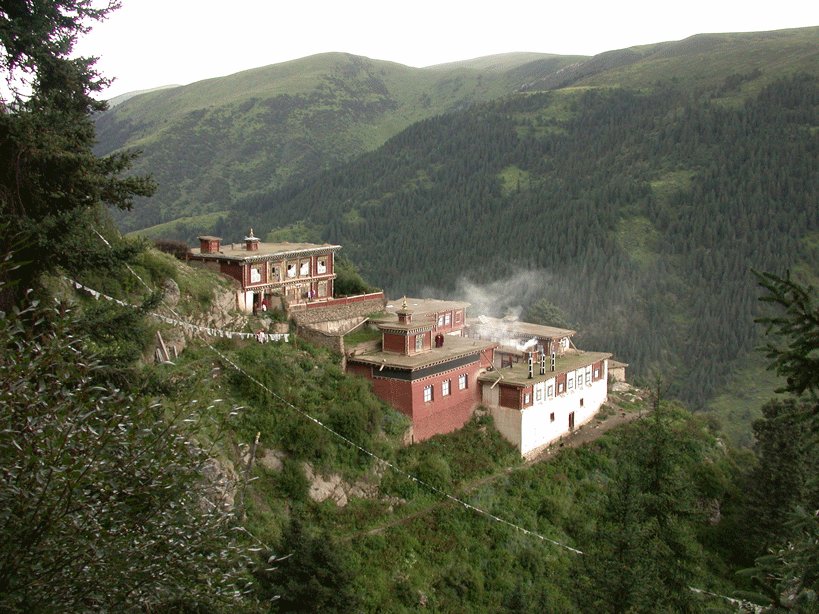Difference between revisions of "Tsadra Rinchen Drak"
SherabDrime (talk | contribs) |
SherabDrime (talk | contribs) |
||
| Line 1: | Line 1: | ||
[[Image:tsadra.jpg|frame|Tsadra Rinchen Drak]] | [[Image:tsadra.jpg|frame|Tsadra Rinchen Drak]] | ||
| − | The hermitage and main seat of [[Jamgön Kongtrul Lodrö Thaye]] (1813-1899), above the [[Palpung]] monastery of the Tai Situ Rinpoches, established in 1858. It is a site sacred to Yangdag Heruka and Vajrakila, and was formally opened by Kongtrul together with the treasure revealer Terchen [[Chokgyur Lingpa]] (1829-1870) in 1857. It had previously been used as a retreat place by the [[8th Tai Situpa]] (1700-1774), but had been abandoned and eventually fallen into disrepair. | + | The "Tsari-like Jewel Rock", hermitage and main seat of [[Jamgön Kongtrul Lodrö Thaye]] (1813-1899), above the [[Palpung]] monastery of the Tai Situ Rinpoches, established in 1858. It is a site sacred to Yangdag Heruka and Vajrakila, and was formally opened by Kongtrul together with the treasure revealer Terchen [[Chokgyur Lingpa]] (1829-1870) in 1857. It had previously been used as a retreat place by the [[8th Tai Situpa]] (1700-1774), but had been abandoned and eventually fallen into disrepair. The terma cycle of "Sangthig Khorsum", containing practices on Yangdag, Vajrasattva and Vajrakila, was revealed here by Chokgyur Lingpa, along with the guide-book to the sacred site. It is here where Jamgon Kongtrul eventually established a three-year retreat center for the practices and teachings of the [[Shangpa Kagyu]] tradition and where he spent most of his life. All around the mountain, many sacred sites, self-arisen designs and syllables, as well as foot- and hand-prints of masters of the past, such as Guru [[Padmasambhava]] and [[Yeshe Tsogyal]] can be found. The red temple in the foreground has recently been enlarged considerably. Technically, it is actually the cliff behind the retreat center that is referred to as Tsadra Rinchen Drak, while the center itself is named Kunsang Dechen Osal Ling. On this cliff, several caves are to be found, most notably the practice caves of [[Namkhai Nyingpo]] and the Indian master Mriti Jnana. Tsadra Rinchen Drak counts as one of the twenty-five sacred sites of the eastern Tibetan province of Kham. [TSD] |
[[Category: Sacred Sites]] | [[Category: Sacred Sites]] | ||
[[Category:Tibet]] | [[Category:Tibet]] | ||
Revision as of 20:20, 27 May 2010
The "Tsari-like Jewel Rock", hermitage and main seat of Jamgön Kongtrul Lodrö Thaye (1813-1899), above the Palpung monastery of the Tai Situ Rinpoches, established in 1858. It is a site sacred to Yangdag Heruka and Vajrakila, and was formally opened by Kongtrul together with the treasure revealer Terchen Chokgyur Lingpa (1829-1870) in 1857. It had previously been used as a retreat place by the 8th Tai Situpa (1700-1774), but had been abandoned and eventually fallen into disrepair. The terma cycle of "Sangthig Khorsum", containing practices on Yangdag, Vajrasattva and Vajrakila, was revealed here by Chokgyur Lingpa, along with the guide-book to the sacred site. It is here where Jamgon Kongtrul eventually established a three-year retreat center for the practices and teachings of the Shangpa Kagyu tradition and where he spent most of his life. All around the mountain, many sacred sites, self-arisen designs and syllables, as well as foot- and hand-prints of masters of the past, such as Guru Padmasambhava and Yeshe Tsogyal can be found. The red temple in the foreground has recently been enlarged considerably. Technically, it is actually the cliff behind the retreat center that is referred to as Tsadra Rinchen Drak, while the center itself is named Kunsang Dechen Osal Ling. On this cliff, several caves are to be found, most notably the practice caves of Namkhai Nyingpo and the Indian master Mriti Jnana. Tsadra Rinchen Drak counts as one of the twenty-five sacred sites of the eastern Tibetan province of Kham. [TSD]
